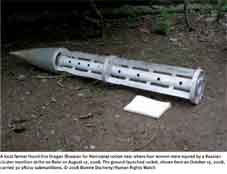Both sides used cluster bombs, says Human Rights Watch
By Etuna Tsotniashvili
Thursday, April 16

According to HRW cluster munitions killed at least 16 civilians in Georgia and injured more than 54. The report says that Georgia provides a vivid reminder of why this notorious weapon should be categorically prohibited. “Cluster munitions always kill and maim civilians, during the fighting and long afterwards,” said Bonnie Docherty, a researcher in the Arms Division of Human Rights Watch and author of the report. “A comprehensive prohibition is the only real solution. The so-called responsible use of cluster munitions is a myth, and nations should resist efforts to weaken the ban,” she added.
The 85-page report, “A Dying Practice: Use of Cluster Munitions by Russia and Georgia in August 2008,” is the first comprehensive report on this subject. Human Rights Watch field investigations in August, September and October 2008 uncovered dozens of civilian deaths and injuries resulting from the use of cluster munitions. There were many casualties after the fighting ended, and unexploded submunitions continue to threaten civilians.
The report writes that the use of cluster bombs in South Ossetia took place less than three months after 107 states from around the world adopted the Convention on Cluster Munitions which bans them. It emphasizes that neither Georgia nor Russia participated in the process of signing that convention and “their use of cluster munitions was in defiance of an emerging consensus on a basic prohibition on the weapon.”
The HRW report says that during their investigations in the conflict zones in September and October they found Russian cluster munitions in seven towns and villages and Georgian cluster munitions in or near nine. “Human Rights Watch researchers took extensive testimony from about 100 witnesses, deminers, and military and Government officials and examined physical evidence. They concluded that Russian weapons caused most of the civilian casualties at the time of the strikes and Georgian cluster munitions killed and injured civilians after, as well as during, attacks. Cluster munitions are large, ground-launched or air-dropped weapons that, depending on their type, contain dozens or hundreds of submunitions,” the report adds, stating that these weapons might be very dangerous for civilians after the conflict because they leave high numbers of hazardous “duds,” that is submunitions that have failed to explode on impact as designed, which unwitting civilians can easily set off.
HRW concludes that during the war Russia used two types of Russian-produced submunitions: the air-dropped AO-2.5 RTM and the ground-launched 9N210. But the Ministry of Foreign Affairs of the Netherlands, which got involved in the investigation after the death of a Dutch cameramen in Gori, claims the Russians also used the surface-to-surface Iskander (or SS-26) missile that carries an unknown model of submunition. Georgia used M85 submunitions delivered by Mk.-4 160mm rockets bought from Israel.
HRW reports that Russian cluster munitions have been found in population centres in Georgia and gives examples. It says three civilians in the village of Variani, 3-4 kilometres from Gori, were victims of cluster munitions which injured 16 people, among whom was a 13-year-old boy, Beka Giorgishvili, who had gone to a friend's house to say goodbye before his family fled town An explosion occurred as he was helping pump up his friend's new bike tyre. Beka lost part of his skull and suffered brain damage; shrapnel remains lodged in his head.
The use of cluster munitions in the conflict zone is categorically denied by the Russian side whereas Georgia publicly acknowledged on September 1 that it deployed ground-launched Mk.-4 160mm rockets carrying M85 submunitions. According to the then First Deputy Minister of Defence and now Georgian Ambassador to the US Batu Kutelia, Georgia fired these rockets only at Russian forces between Tskhinvali, the capital of South Ossetia, and the Roki Tunnel on the border with Russia.
At the end of the report HRW gives some suggestion to both sides. “Russia and Georgia should sign and ratify the Convention on Cluster Munitions as soon as possible. Doing so has the added benefit of making parties affected by this conflict eligible for international assistance for remedial measures, including clearance and risk education. If they cannot commit at this point, Russia and Georgia should take immediate interim measures to minimize the humanitarian harm of cluster munitions. In compliance with the rules on targeting under the laws of war, they should make no future use of cluster munitions in populated areas,” the report writes.
